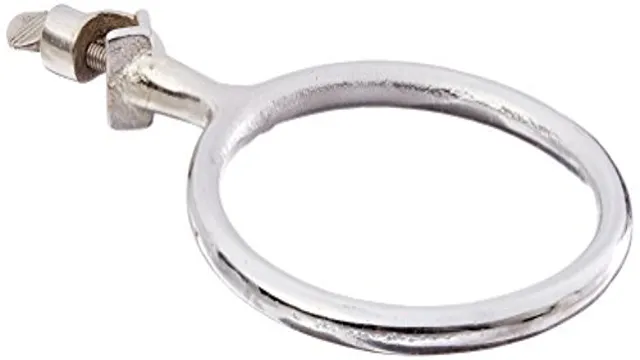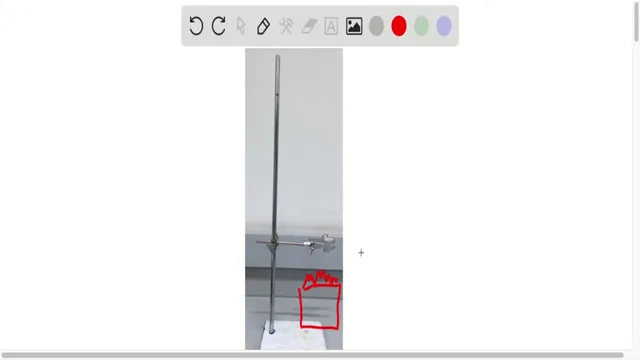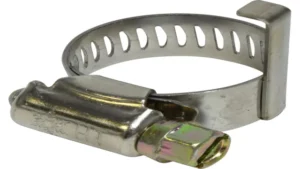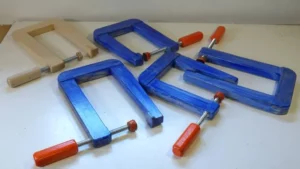Have you ever noticed the clamps and ring stands in a chemistry laboratory and wondered why they are so important? These tools are essential for any chemist as they provide stability and support during various experiments. Without them, many chemical reactions could turn dangerous as they require precise handling and positioning. A clamp is a device that holds two objects tightly together, while a ring stand is used to support various objects, including beakers, flasks, and test tubes.
Together, these tools provide a sturdy foundation for any chemical reaction, ensuring maximum safety and accuracy. In this blog post, we will explore why chemists use clamps and ring stands, their importance in the laboratory, and how they make experiments more reliable.
Introduction
Have you ever wondered why chemists need clamps and ring stands in their laboratory? Well, let me tell you! Chemists use clamps and ring stands to secure glassware and other lab equipment in place during experiments. Without these essential tools, glassware may fall or spill, causing potential harm to both the chemist and the experiment. Additionally, clamps and ring stands allow for greater precision and control during experiments, as they can be adjusted to hold equipment at specific heights and angles.
They provide a stable platform for heating, cooling, and mixing substances, allowing chemists to carry out their experiments safely and accurately. The use of clamps and ring stands is vital in the field of chemistry, and their importance cannot be overstated.
Definition of Clamps and Ring Stands
Clamps and ring stands are essential tools in any laboratory or workshop. A clamp is a device that holds objects securely in place, perfect for those activities that require a stable and balanced setup. You can clamp objects of different shapes and sizes, like test tubes, beakers, and flasks, using different types of clamps such as pinch clamps, burette clamps, and three-prong clamps.
On the other hand, a ring stand is a metal support system that includes a vertical pole, a weighted base, and a clamp or ring that secures the object. This tool is especially useful in experiments that involve heating, such as distillation or reflux, wherein you need to secure the glassware and suspend it over a heat source. In a nutshell, clamps and ring stands are the foundation of any laboratory setup and are essential in conducting experiments with precision and safety.
So, whether you’re a scientist, a student, or a DIY enthusiast, make sure to have these tools in your arsenal.

Safety in the Laboratory
When it comes to working in a laboratory, safety should always be a top priority. Without proper precautions and management, there can be grave consequences that range from minor injuries to devastating accidents. That’s why before starting any work, it’s crucial to understand the risks involved and how to mitigate them.
Chemical spills, explosions, and fires are just some of the potential hazards that laboratory workers can face. Knowing how to handle chemicals properly, wearing appropriate protective equipment, following guidelines, and ensuring proper ventilation are essential steps in reducing the risk of accidents. Ultimately, safety is a collaborative effort, and all laboratory users should play their part in promoting a safe working environment.
By incorporating safety measures into every aspect of working in the laboratory, the chances of accidents occurring, and injuries and damage being caused, can be significantly minimized.
Uses of Clamps and Ring Stands
Clamps and ring stands are vital tools in a chemistry lab. Chemists use these tools for different purposes such as holding test tubes, beakers, flasks, and other lab equipment, and also for holding up glassware when heating substances. Clamps provide proper support for glassware during complicated experiments and protect against breakage.
Also, when carrying out reactions that require a specific temperature range, clamps and ring stands allow the chemist to hold the reaction vessels at the correct height to ensure the reaction occurs safely and effectively. Additionally, clamps and ring stands aid in maintaining a clean workspace, ensuring that equipment is not cluttered, minimizing the chance of spills and breakage. In overall, the use of clamps and ring stands ensures safety, practicality, and effective results, which are all vital in any chemistry lab.
Holding Glassware in Place
When it comes to holding glassware in place, there are a few helpful tools that come to mind. Clamps and ring stands can be incredibly useful in the laboratory or in any situation where glassware needs to be secured. Clamps can be used to hold test tubes, flasks, or beakers securely in place on a ring stand, which offers a sturdy metal base and a variety of attachment points.
With the right combination of clamps and ring stands, you can ensure that your glassware stays in place during experiments or procedures, reducing the risk of spills or accidents. Plus, using clamps and ring stands can help you keep your workspace organized and efficient, as you won’t have to constantly adjust your glassware as you work. So next time you need to hold glassware in place, consider using clamps and ring stands for a reliable and convenient solution.
Distilling and Fractionating
When it comes to distilling compounds and separating mixtures, clamps and ring stands are essential tools in the laboratory. These items are used to secure glassware during experiments to prevent spills or accidents. Distilling involves heating a liquid to create a vapor, which is then condensed and collected in a separate container.
Fractionating, on the other hand, is a similar process that is used to separate a mixture of compounds based on their boiling points. In both cases, clamps and ring stands are necessary to hold the equipment in place and ensure precision during the process. Without them, it would be difficult to achieve accurate results and maintain safety in the lab setting.
So, if you’re planning to conduct experiments using these methods, make sure to have these tools handy!
Supporting Apparatuses
Clamps and ring stands are valuable supporting apparatuses that every laboratory should have. Clamps are used to hold test tubes, flasks, beakers, or any other laboratory apparatus in a fixed position during experiments. Ring stands serve as support for clamps and can be used to hold various objects such as burettes, flasks, or funnels at a specific angle during experiments.
Both clamps and ring stands are essential for any laboratory experiment as they ensure the equipment is held in place and prevent accidental spillage or breakage. Using clamps and ring stands is not only important for safety, but it also helps to make experiments more accurate. By securing the apparatus in one place, it eliminates the risk of errors due to movement or vibration.
Clamps and ring stands come in various shapes and sizes, and it’s vital to choose the one that suits your specific experiment. For instance, if working with a burette, a burette clamp will be appropriate to hold it in place. In conclusion, clamps and ring stands are crucial for any laboratory experiment.
They provide support for equipment and ensure that experiments are conducted safely. With various types of clamps and ring stands available, selecting one that suits your experiment’s specific needs is essential. By utilizing these apparatuses, you’ll have a more successful experiment with accurate results.
Varieties of Clamps and Ring Stands
Clamps and ring stands are essential tools in any chemistry lab. These devices help chemists secure glassware and equipment in place, ensuring the safety of the experiment and accuracy of the results. A clamp is a device that holds two objects together by exerting pressure.
It is commonly used to hold test tubes, flasks, and other lab equipment securely in place. A ring stand, on the other hand, is a metal support with a vertical rod that holds clamps and other lab equipment. It is usually placed on a bench or table to provide a stable base for experiments.
Chemists use clamps and ring stands because they offer a safe and effective way to hold equipment in place, preventing spills and accidents. They also allow chemists to perform hands-free experiments, freeing up their hands to make observations or take measurements. Overall, clamps and ring stands are essential tools that enable chemists to carry out their work safely and efficiently.
Types of Clamps
Clamps come in various types, each designed for specific applications. The most common type is a spring clamp that is used to hold objects together temporarily. C-clamps, also known as G-clamps, are much stronger than spring clamps and come in various sizes and shapes for a range of applications.
They are designed to firmly hold objects together, and the screw mechanism allows for easy adjustments. Another type of clamp is a bar clamp, which is used for welding or woodworking projects. It has a long bar that extends to apply pressure and keep items securely in place.
Ring stands are also common clamping devices in science experiments. These are used for securely holding test tubes, beakers, and flasks in place. They comprise a base, rod, and clamp that can be adjusted to the desired height and angle.
In summary, using the right type of clamp will depend on the project’s nature and requirements, and having a variety of clamps can be helpful for different applications.
Types of Ring Stands
Ring stands are essential for laboratories, and they come in various forms to cater to different needs. One common type is the basic ring stand that consists of a circular base and a rod. It is ideal for holding clamps and attachments, such as buret clamps and utility clamps, which secure lab apparatus to the rod.
Another type of ring stand is the tripod stand, which has three legs instead of a circular base. This design provides greater stability to the apparatus placed on it. A universal clamp is another critical attachment that can hold multitasking lab gear, whereas a three-finger clamp is an excellent option to hold round glassware.
Other ring stand varieties are the H-Shaped Base, which maximizes flexibility and stability in the lab, and the Cast-iron Ring Stand, which is ideal for heavier equipment. Overall, the variety of ring stands ensures different apparatus can be mounted and secured efficiently, ensuring the safety and accuracy of all lab experiments.
Conclusion
In conclusion, chemists use clamps and ring stands for the same reason Batman uses his utility belt – to keep their experiments safe, stable, and under control. From holding up glassware to preventing hazardous spills and accidents, these tools are essential to any chemist’s arsenal. So next time you see a chemist with a clamp in hand, remember – they are the superheroes of the lab, fighting for the safety of our world, one experiment at a time.
“
FAQs
What is the purpose of using clamps and ring stands in chemistry?
Clamps and ring stands are used to hold and support objects like flasks and beakers during chemical reactions. They provide stability and prevent spills.
How do clamps and ring stands improve safety in a chemistry laboratory?
Clamps and ring stands help prevent accidents by holding materials securely and reducing the risk of spills or tipping over. They also keep materials away from direct contact with heat sources.
Are there different types of clamps and ring stands used in chemistry?
Yes, there are different types of clamps and ring stands used in chemistry. Examples include buret clamps, utility clamps, and three-fingered clamps, each designed for specific purposes.
What materials are used to make clamps and ring stands in chemistry?
Clamps and ring stands in chemistry are usually made of metal alloys like stainless steel or aluminum. Some may also be made of plastic or other materials.
How do you properly set up clamps and ring stands in a chemistry experiment?
To properly set up clamps and ring stands in a chemistry experiment, attach the clamp to the stand and adjust it to the desired height and position. Then, attach the object to be held securely in the clamp.
Why do chemists need to use clamps and ring stands in experiments involving heat?
Clamps and ring stands are essential in chemistry experiments that involve heat because they help support and stabilize objects that may become hot or volatile during the reaction.
What should you do if a clamp or ring stand fails during a chemistry experiment?
If a clamp or ring stand fails during a chemistry experiment, immediately stop the experiment and notify the teacher or lab manager. Do not attempt to adjust or fix equipment without proper training.






